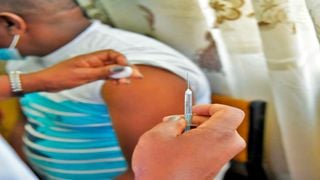
A medic prepares to vaccinate a government worker against Covid-19 at the office of the Rift Valley Regional Coordinator in Nakuru town on March 12, 2021.
| File | Nation Media GroupNews
Premium
Kenya estimates 10pc vaccine wastage amid biting shortage
What you need to know:
- Wastage rates are calculated to help in forecasting to estimate jab requirements and cost.
- Those aged 58 and above and non-priority groups continue to constitute the bulk of those vaccinated at 365,178.
Kenya expects to record an average vaccine wastage rate of 10 per cent or less in the ongoing inoculation drive.
The national task force on vaccine deployment said about 651,650 people have received the Covishield vaccine since the exercise kicked off over a month ago.
Those above 58 and non-priority groups continue to constitute the bulk of those vaccinated at 365,178, followed by healthcare workers at 136,084, teachers (97,786), and 52,602 security officers.
While tabulating its inoculation numbers on Thursday, something strange had happened: Nyeri County said it had vaccinated 233 more people than the 23,500 doses they had received.
Wastage may occur when a closed vial cannot be used primarily due to ineffective temperature control, monitoring, and stock management during storage and transportation. This may be due to expiry, excess heat exposure, freezing, breakage, missing inventory, or discard following outreach session.
An open vial may also be wasted because of immunisation workers’ practices and discarded doses from vials of unused doses of multi-dose vials.
Reducing stock-outs
Vaccine wastage rates are calculated to help in forecasting to facilitate the estimation of jab requirements and cost. Accurately calculating the wastage rate is essential for reducing stock-outs and over-stock, choosing the most appropriate vaccine presentation and immunisation session size, as well as sizing supply chain infrastructure at the country level.
At the global level, the vaccine wastage rate is a key input in forecasting global vaccine access programmes.
The variation in the number of doses administered in some counties amid increased concerns of vaccine shortage and wastage in the country has prompted the Ministry of Health to give an explanation, saying that while each vial contains at least the number of doses stated, it is possible to withdraw additional doses depending on the size.
A vial is a small container, typically cylindrical and made of glass, used especially for holding liquid medicines.
In the case of the Indian-made Oxford/AstraZeneca vaccine marketed as Covishield, each vial contains between eight and 10 doses. This means one vial can be used to vaccinate 10 people at most.
The World Health Organisation (WHO) recommends that opened vials should be discarded either six hours later, or at the end of the immunisation session, whichever comes first, else the remaining doses go waste and have to be destroyed.
This destruction amounts to what is known as vaccine wastage, which the WHO defines as the sum of vaccines discarded, lost, damaged, or destroyed.
While each vial contains at least the number of doses stated, it is possible to withdraw additional doses depending on vial size, said the task force.
“Some manufacturers include some ‘overage’ or extra quantity in a vial to cater for losses when vaccines are being drawn into syringes,” the task force noted yesterday.
Depending on the type of syringes used, the remaining quantity in the vial may yield one or two extra doses.
“This has been observed during the use of the Covishield® vaccine in Kenya. The development has also been observed in other countries conducting Covid-19 Vaccination, such as the United States of America,” the task force said.
The ability to get an extra dose from the vials has also been attributed to the use of what is referred to as ‘low dead volume syringes’. When a medication or vaccine is injected, some amount of it can linger in the syringe in what is known as the “dead space” (also called dead-volume) within the syringe and needle after an injection is completed.
“This in effect leads to a negative wastage rate where more people are vaccinated from one vial than the expected number of doses,” the task force stated.
Strict guidelines
Health workers have, however, been advised to strictly follow guidelines on the use of the vaccines.
“As such, should a half-used vial of vaccine reach the discard time, the remaining doses will be discarded and recorded as a wastage. This wastage is monitored on daily basis,” said the task force.
There are key things to know about the Covishield vaccine being used in Kenya: The vaccination course consists of two separate doses of 0.5 ml each. The shots have a shelf-life of six months when stored between 2 and 8 degrees celsius.
According to WHO recommendations, the second dose should be administered after eight to 12 weeks.
Since vaccines account for a significant portion of immunisation programme costs, ensuring that wastage is minimised without jeopardising vaccination coverage is key.
The package insert and factsheet come with the vaccine, includes information on indications, dosage strength and administration, usage, effects, drug reactions, clinical efficacy, contraindications, risks and benefits, and use in specific populations.





